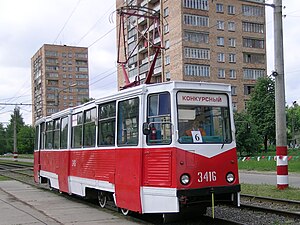KTM-5
| KTM-5 (КТМ-5) | |
|---|---|
|
71-605 (KTM-5M3) No. 3416 in Nizhny Novgorod
|
|
| Number: | 14991 |
| Manufacturer: | Ust-Katawer wagon construction factory |
| Year of construction (s): | 1963-1992 |
| Axis formula : | Bo'Bo ' |
| Gauge : | 1,524 mm, 1,435 mm |
| Length: | 15.094 mm |
| Height: | 3,120 mm |
| Width: | 2,550 mm |
| Trunnion Distance: | 7,500 mm |
| Bogie axle base: | 1,940 mm |
| Empty mass: | 18.6 t |
| Top speed: | 75 km / h |
| Hourly output : | 4 × 45 kW = 180 kW |
| Driving wheel diameter: | 710 mm |
| Motor type: | DK-259 |
| Power system : | 550-600 V DC |
| Power transmission: | Overhead line |
| Number of traction motors: | 4th |
| Operating mode: | Unidirectional locomotive |
| Seats: | 32-35 |
| Standing room: | 187–192 (8 / m²) |
KTM-5 ( Russian КТМ-5) is the name of a four-axle tram - railcar type built by the Ust-Katawer Waggonbaufabrik in Ust-Kataw ( Soviet Union , today Russia ) . After the Tatra T3 in Czechoslovakia, it is one of the most built trams in the world.
history
The designation "KTM-5" is usually used today for the most common sub-type KTM-5M3 (71-605). The development of the KTM-5 type included several development stages and sub-types.
KTM-5
In 1963, two four-axle prototypes with a rounded car body shape were built and delivered to the Chelyabinsk tram for testing . A series production of this type did not follow.
KTM-5M
Another prototype was built in 1966. From 1969 the series production of the type KTM-5M, which replaced the two-axle type KTM-2 . The angular plastic car body, which was unusual at the time, and the three large motor-driven, external sliding doors were striking . Around 620 KTM-5M (also known as the "Ural" type) were built up to 1971.
KTM-5M3 (71-605)
In 1971, the changeover to the type KTM-5M3 (designated as 71-605 from 1976), which differs from the KTM-5M in an externally almost unchanged metal car body with corrugated side panels and unpadded seats. By 1990 12,943 KTM-5M3s had been built, the largest number ever built by a type of tram car in the Soviet Union.
71-605A (KTM-5A)
From 1989 to 1992 a slightly modified variant was built in a number of 1426 railcars.
71-605U (KTM-5U)
All KTM-5s built before 1990 had a track width of 1524 mm. For the tram in Rostov-on-Don , which is the only one in the Soviet Union to use the European standard gauge of 1435 mm, 45 standard-gauge KTM-5Us were built from 1990 to 1992. Except for the gauge, they correspond to the KTM-5A type.
71-605RM (KTM-5RM)
From 2001 onwards, some KTM-5M3 of the Voronezh tram were modernized and designated as KTM-5RM. The trams in Kemerovo and Usolye-Sibirskoye also received some modernized vehicles of this type.
commitment
KTM-5 were used by most of the tram operators in the Soviet Union. Since the KTM-5 was only supplied in a wide-gauge version, it was not used on narrow-gauge trams. The largest tram companies in the Soviet Union (including Moscow , Kiev and Odessa ) did not receive a KTM-5, but Tatra T3 . The Leningrad tram only procured KTM-5s in 1982 and 1983, when the in-house wagon factory was unable to deliver due to renovation work. Some companies only received KTM-5 after the dissolution of the Council for Mutual Economic Aid (RGW) and the associated end of the Tatra T3 deliveries.
The KTM-5 were built exclusively as railcars, sidecar operation was not intended. At some companies, however, the KTM-5 are used in double traction.
The successor of the KTM-5 is the KTM-8 , which, however, achieved significantly lower numbers.
gallery
KTM-5 (KTM-5M3) of the Konotop tram (2007)
KTM-5 (KTM-5M3) of the Slatoust tram (2007)
Newly covered KTM-5 (KTM-5M3) in Mariupol (2007)
KTM-5RM in Voronezh (2006)
literature
- Aare Olander: Tram atlas of the former Soviet Union. Working group Blickpunkt Straßenbahn eV, Berlin 2003, ISBN 3-926524-21-9 .
Web links
-
Page «Trams in St. Petersburg»
- Work car based on KTM-5
- Photos of the St. Petersburg KTM-5 (no longer in use)
- Page «Russian trams»
- KTM-5 description (Russian)
- KTM-5M description (Russian)
- KTM-5M3 description (Russian)
-
Page «Tram of the Nizhny Novgorod», 71-605 carriages (Russian)
- History (russ.)
- Photos (russ.)
- Technical data (Russian)
- Parts and devices (Russian)





